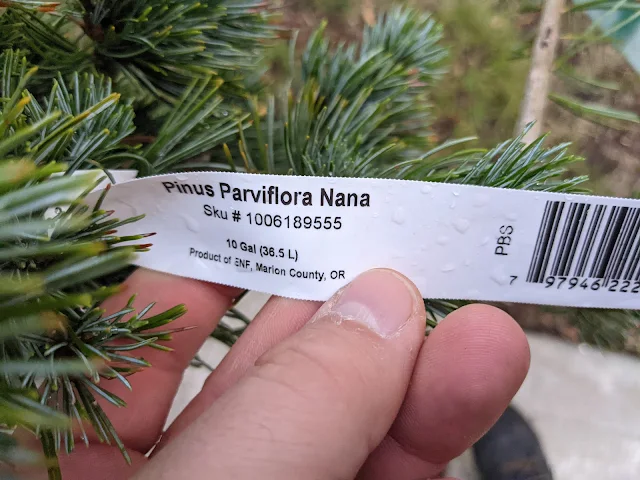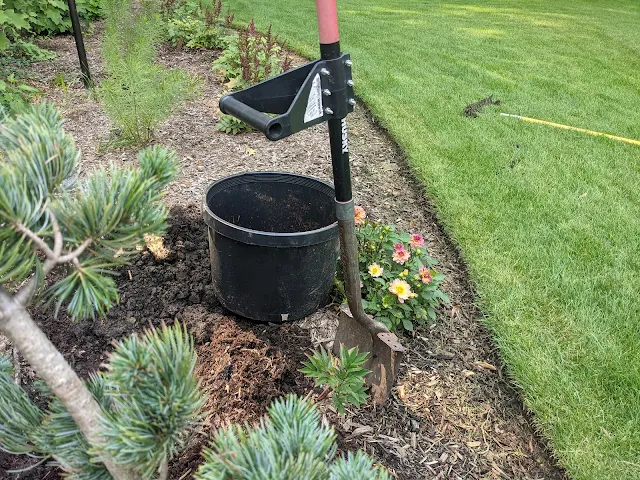Pinus Parviflora 'Glauca Nana' - Japanese White Pine Added - July 2021
One of the things that I had on my 2021 to-do list (#25) was to 'buy a conifer of meaning'. I feel like I *did that* when I planted the Weeping Nootka Falsecypress that I bought this Spring from Wannemakers. That was the 55th tree planted in total since we bought the lot and the third of this year. And after cleaning up the full list this Spring, I had 34 alive.
We then added this Emperor 1 Japanese Maple - bringing total to 56 total, 35 alive. Fourth tree for the 2021 season.
Since then, I planted two Harvest Gold Hargozam crabapple trees as replacements in our Belgian Fence espalier - but I didn't include them in the 'official count'. So, I'm doing that now. 58 total, 37 alive, six trees for the 2021 season.
Which brings me to the tree in this post #59 total, 38 'alive' and seventh tree of the 2021 growing season: another conifer 'of meaning'. A dwarf Japanese White Pine.
I've been thinking/dreaming/watching/considering a columnar pine for a while. I have posted about the various pines that exist in Japan and how they aren't always suitable for our Zone (black pines, white pines, etc) but that hasn't stopped me from keeping them on my radar. So, imagine my surprise when one one of my trips to one of the local Home Depots near me I see a pallet of some upright conifers. When I take a closer look, I see this tag:
I whip out my phone and quickly learn that Pinus parviflora is a Japanese White Pine. What the what? I went home and started to dig around. This tag includes nana as the sport, so I started broadly with general searches on Pinus parviflora and saw this identifier attached: Glauca Group. I wasn't totally satisfied with the answers - because I found definitive reports around 'Glauca', 'Ogon janome', 'pygmy Yatsubusa' and more. But, 'Nana' was either not present or I was getting conflicting information. The Missouri Botanical Garden lists 'Nana' as 'Glauca Nana' - and so does Monrovia. The listing from the Missouri Botanical Garden includes this description:
‘Glauca Nana’ is an upright, slow-growing (3-6" per year), dwarf form with short, twisted, blue-green needles. It is a more compact and narrower form than Pinus parviflora 'Glauca'. It typically grows to only 2' tall and to 1' wide over the first 10 years.
The problem there is that they say the tree will only get to 2' tall in ten years. The tree I'm staring at in the Home Depot parking lot is like 40" tall. The Monrovia listing says:
A narrower, more compact and upright form with short blue-green to gray needles. Widely used as bonsai or container plant. An easy to care for evergreen that works beautifully as a landscape specimen. Slowly growing; reaches 6 to 10 ft. tall, 3 to 5 ft. wide in 10 years.
That seems more appropriate. Not to mention, the photo on their listing looks a lot MORE like what I was seeing at Home Depot.
But, I wasn't satisfied, so I keep looking around the gardening Web. I found this post on A Way to Garden from Margaret Roach - which...hit me right between the eyes. She has a similar tree and shed some light on the 'Nana' name:
I know I said the plant is specifically Pinus strobus ‘Nana,’ and that’s how mine came to me, but here’s the wrinkle: ‘Nana’ is kind of a grab-bag name for many relatively compact- or mounded-growing Eastern white pines, a long-needled species native to Eastern North America, from Canada to Georgia and out to Ohio and Illinois.
A ha! It seems like the threads of the REAL answer are starting to get pulled together: Monrovia with the tip towards the *right* name - 'Glauca Nana' and Margaret from A Way to Garden telling me that commercial nurseries use 'Nana' as a sort of catch-all naming convention.
Knowing all of that, I still didn't buy the tree. They were asking - for me - A LOT of money for a tiny tree. And, the tree, itself, is NOT a showstopper if you see it in the parking lot. Lots of trunk showing. It was packed in a burlap ball that was then tucked into a 10# nursery container that was then filled with mulch. That meant that the trees were pointed this way/that way and not standing straight up. So, a not-so-sexy profile + a high (again...for me) price tag = a tree that wasn't going to fly out of the store. Also, there were like four of them.
Recently, like a few other things, all of Home Depot's trees went on 50% off sale. I also had a bunch of Menards-match 11% rebate cards from Home Depot, so the price suddenly felt like it was a no-brainer for something that I wanted in our garden. So, I brought one home and tucked it into the bed on the southside of our backyard, where you can see it from our kitchen windows.
Here, below, is the tree in the ground. I used a bamboo pole to support it from bending over because it is top-heavy. I really like it and am happy with it now that I've planted it.

59 trees planted/5 growing seasons = 11.8 trees on average planted each season.
38 trees alive/5 growing seasons = 7.6 trees on average survive each season.
1. Flowering Pear in backyard on north side.
3. Japanese flowering cherry
4 and 5: 2 Lindens that I espalier'd and placed by the south fence line near our kitchen windows.
7. Nat's Saucer Magnolia in our front yard
2018 (17 planted. 6 Dead):
14, 15, 16, 17, 18, 19, 20, 21. These Frans Fontaine Hornbeams.
22. A replacement Chanticleer Pear tree (3" caliper) out front by our garage
25. Our replanted/replacement Dawn Redwood. Same spot as the first.
26. This teeny-tiny Bald Cypress that I planted in the front yard, in between our driveway and our neighbor to the north.
33. My new Weeping White Spruce that will only grow about 4' wide placed near the fence line alongside the espalier'd Lindens.
35. T
46. A small Northern Red Oak tree - our first Oak tree planted.
47. A 'decapitated' Lavender Twist Weeping Redbud that I planted on a whim.
49. A tall(ish) London Plane tree that suffered some transplant and frost shock, but seemed to recover.









This post is EXACTLY what I was looking for!!! I just bought a blue-looking pine from the Home Depot by my house that had no markings on it whatsoever. No one in the store could identify the tree so they sold it to me at a discount. I could not identify it until I came across a few posts that had Japanese White Pines and then your post shows the exact tree I have. How is it doing? Thanks again for posting the photos and the description!
ReplyDeleteHi Jake. I’m in Westmont, loving the look of the same “nana” tree up at HD. Wondering if I should get it, $99. How is yours doing?
ReplyDeleteHi there. Ours didn't make it. I don't know if it was the zone and not being hardy enough. Or, if it was stressed somehow. I really liked it, too. If they give you the 1 year guarantee, then go for it!
DeleteJust checking to see if I can post on your blog -hope so
DeleteJAKE -I am delighted to find your blog -we have some mutual interests -gardening, landscaping, college football ( K-State fan , not player, so I am aware of feelings of some wonderful success, some hopefulness, and the disappoint of failure, which is why I compare the emotions of a football fan to that of grand opera -great swells and ebbs of emotion). To the point -I was searching for Pinus parviflora nana because, I spotted two at my HD (Wichita, Ks zone 7b); all shrubs and trees were 50% off so I purchased one, brought it home , went back the next day and purchase the other. Have had one in the ground for about 6 weeks ( during this brutal hot, dry summer) which seems to be doing fine, and am in process if locating “correct” place for the other. I find them to be beautiful and interesting and, indeed, potential STARS . Have two weeping white pines -doing very well, several Hinoki ( awfully hot sun this year -had to move one) incense cedars, red dawn redwoods, and multiple Japanese maples which are interesting and fun because of their differing looks and their sun/shade requirements. I am fascinated by your planting list and looking forward to following your advances, successes, and failures ( I guess this planting interest is also kind of like the ups and downs of football and grand opera. Thanks for your information regarding my two baby pines ! R J. Gump KSU VET MED 69
ReplyDelete